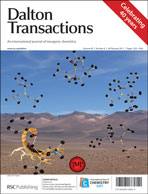Eight inorganic–organic hybrid compounds with a formula of [R-Bz-1-APy][PbI3] (R-Bz-1-APy+ = mono-substituted benzylidene-1-aminopyridinium Schiff base derivative; R = m-CN (1), m-CH3 (2), H (3), p-F (4), p-Cl (5), p-Br (6), o-Cl (7), o-Br (8)) have been synthesized and characterized structurally. The common characteristic of the crystal structures of 1–8 is that the inorganic components form straight and face-sharing octahedral [PbI3]∞ chains and the Schiff base cations surround the [PbI3]∞ chains to form molecular stacks. The substituent (R) on the phenyl ring of the Schiff base cation clearly influences the packing structures of 1–8, and the hybrid compound crystallizes in the space groupP63 when R = CN (1) in the meta-position of the phenyl ring, and in a central symmetric space group when R is in the ortho- or para-position of the phenyl ring. The conformation of the Schiff base cation is related to the R position, and the dihedral angle between the phenyl and pyridyl rings increases in the order of para- < meta- < ortho-position substitution of the phenyl ring. The long molecular axis of the Schiff base cation adopts a manner approximately parallel to the straight inorganic [PbI3]∞ chain in the para-substituted hybrid compounds, and perpendicular to the straight inorganic [PbI3]∞ chain in the ortho-substituted hybrid compounds. 1 is second harmonic generation (SHG) active with a comparable response as that of urea and also exhibits ferroelectricity with larger Ps and Pr values; 1–8 emit multi-band luminescence in the 300–650 nm regions under the excitation of ultraviolet light.
![Graphical abstract: Inorganic–organic hybrid compounds based on face-sharing octahedral [PbI3]∞ chains: self-assemblies, crystal structures, and ferroelectric, photoluminescence properties](/en/Image/Get?imageInfo.ImageType=GA&imageInfo.ImageIdentifier.ManuscriptID=C0DT00875C&imageInfo.ImageIdentifier.Year=2011)
You have access to this article
 Please wait while we load your content...
Something went wrong. Try again?
Please wait while we load your content...
Something went wrong. Try again?
![Graphical abstract: Inorganic–organic hybrid compounds based on face-sharing octahedral [PbI3]∞ chains: self-assemblies, crystal structures, and ferroelectric, photoluminescence properties](/en/Image/Get?imageInfo.ImageType=GA&imageInfo.ImageIdentifier.ManuscriptID=C0DT00875C&imageInfo.ImageIdentifier.Year=2011)

 Please wait while we load your content...
Please wait while we load your content...